Are you reluctant to bake bread? Fear no more! Here are my helpful tips and solutions to the common mishaps with baking bread. After reading my ultimate guide for beginners, you’ll feel confident in baking my 90-minute man bread or my overnight Artisan bread.
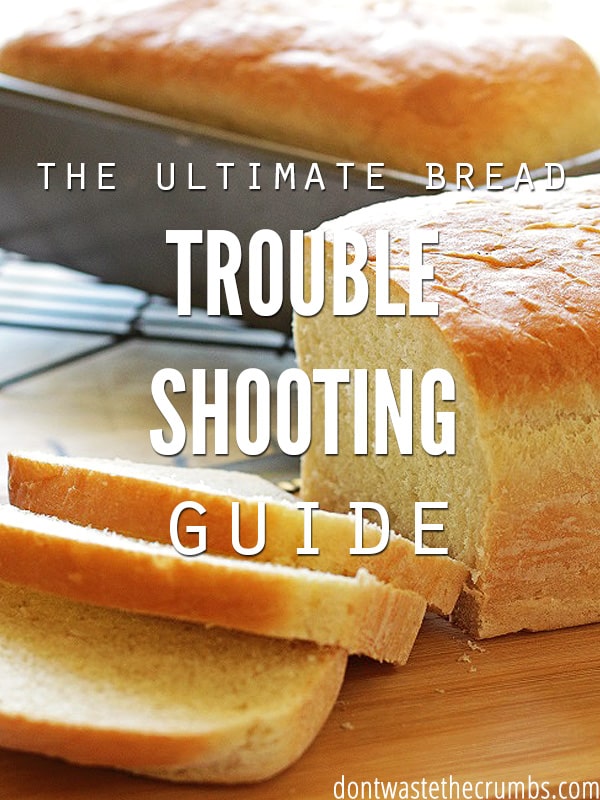
The feeling of successfully making my first loaf of homemade bread was euphoric.
Mr. Crumbs, the company we invited over for dinner, and even the kids were amazed. “You made this?!” they asked.
Like a proud mother hen, I was beaming over that bread.
Little did they know that just a few days earlier, my loaves were about as tasty and dense as a hockey puck.
It takes trial and error to get a loaf of bread just right, but with each failed recipe comes lessons learned to help make the next batch that much better.
Lucky for the novice bakers out there, this ultimate guide to troubleshooting bread is the crash course on what might have gone wrong with your baking extravaganza.
Like the ultimate guide to freezing bread and yeast 101, you’re gonna want to keep this one handy!!
Tips & Helpful Facts About Baking Bread
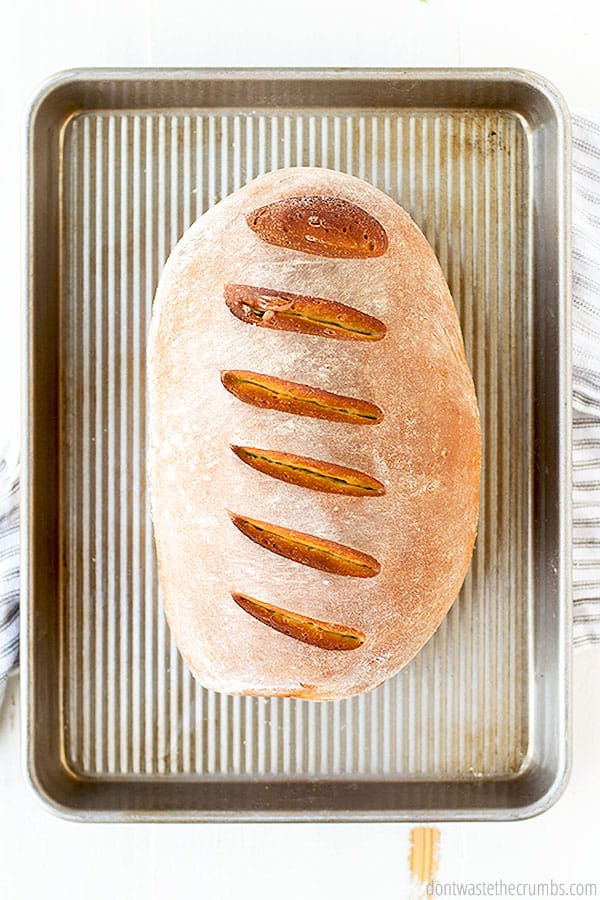
- When proofing yeast, water should be between 105F and 115F. (Read more about yeast HERE.)
- Air temperature during the rise(s) should be between 75F and 85F.
- The purpose of kneading is to allow the gluten to develop. Too short or too long of a knead will affect the texture of the bread.
- A general rule of thumb is the ratio of flour to water is 2:1 by weight (i.e. 6 oz bread flour for 3 oz water).
- Bread is done when it sounds hollow when tapped underneath or reaches 190F on a thermometer. It’s better to over-cook by a few minutes than under-cook.
- Once you’ve added the flour to the recipe, knead just until ingredients are combined, and then let the dough rest for 10 full minutes. Continue with the recipe as written. This provides a better-textured bread.
- If you’re not sure if the dough has doubled in size, flour two fingers and stick them in the dough. If the indentation stays, it’s ready. If the indentation springs bag, let the rise continue.
- Over-kneading – at any stage – will affect the outcome of the bread. Knead and handle only as necessary.
- Gently pushing the shaped dough into the corners of the loaf pan will help create a more even loaf.
- Take five minutes and make a flour shaker. And these mats might be your new best friend.
Problems with the Dough
Q: Why is my dough really sticky?
A: Either there wasn’t enough flour, there wasn’t enough gluten in the dough or there was too much kneading.
Fix: Add more flour 1 tablespoon at a time, but no more than 1/2 cup. Dough that is too dry might not rise well and could result in a dense loaf. Be sure to use flour that contains enough gluten, or add vital wheat gluten to the dough (1 Tbsp per 1 cup of flour). Knead only until the dough is smooth and elastic, and no more.
Problems with the Yeast
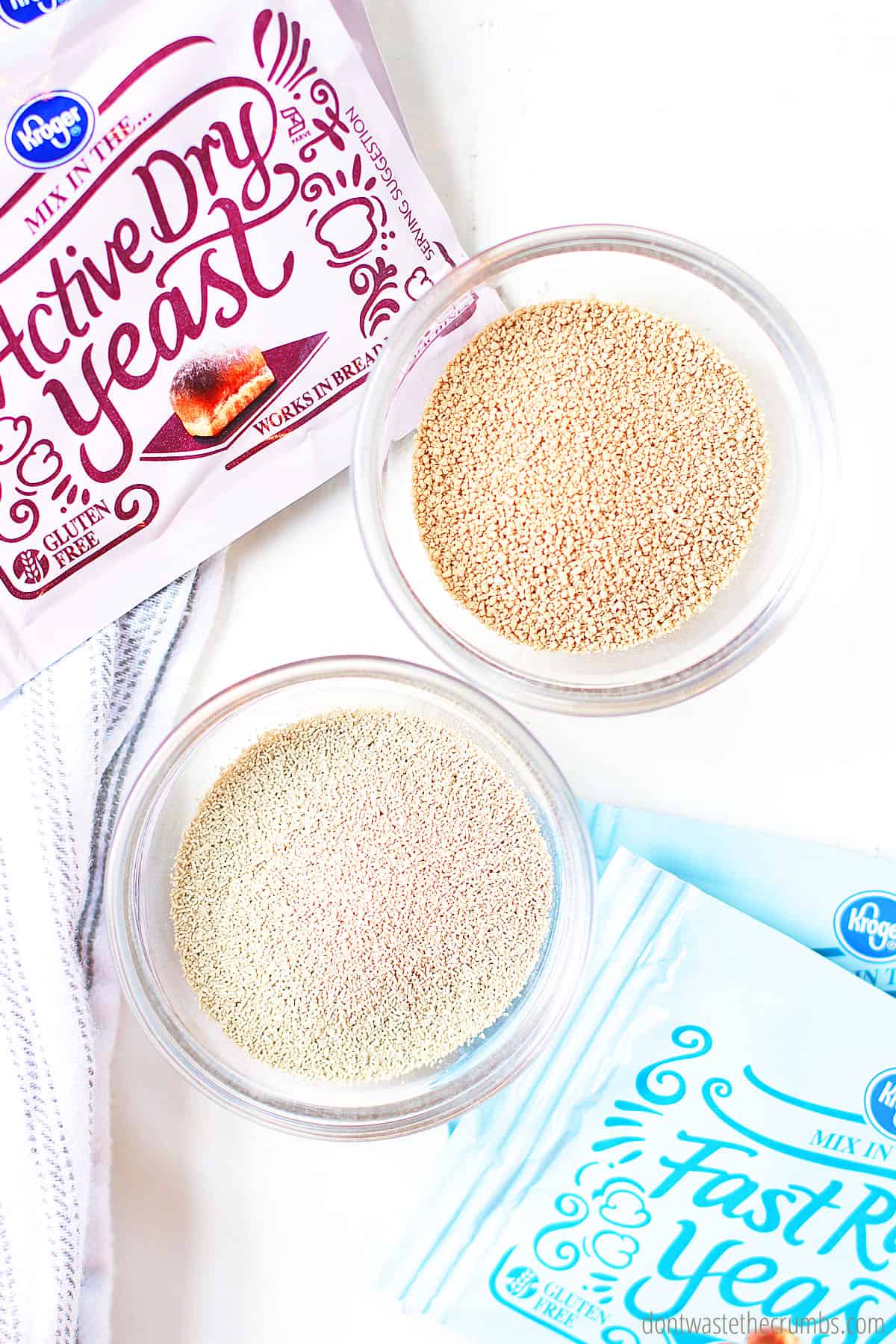
Q: Why didn’t my yeast bubble up with beer foam?
A: If you don’t see any yeast bubbles in your mixing bowl, there are one of 3 problems: either the yeast is dead, the water was too hot, or the water was too cold.
Fix: Try again and make sure the water is between 105F and 115F. Adding a little bit of sugar (no more than the amount of yeast) will help as well. (Read more about different kinds of yeast like the rapid rise and active dry yeast HERE.)
Problems with the Dough Rise

Q: Why didn’t my bread rise at all, it only rose a little bit or took a really long time to double in size?
A: Either the yeast wasn’t active or the environment was too cold. It helps to place a towel, lid, or plastic wrap over the large bowl that your dough is in, so it contains the temperature.
Fix: Proof your yeast first, making sure the water is between 105F and 115F. Then allow the dough to rise in a warm – not hot, not cold – place. (Read more about yeast HERE.)
Q: Why does my cinnamon roll recipe take longer to rise than my sandwich bread?
A: Milk, eggs, and butter interfere with the rising of yeast, and therefore recipes using these ingredients tend to take longer to rise.
To counteract this, either allow for a longer rise time, place in a warmer environment or use more yeast.
More Baking Bread FAQs
It could be the weight of the grain, too short of a knead, or too long of a rise.
Try altering the types of grain used. “White” flour is generally all-purpose flour. Bread flour is made from wheat with a naturally higher content of gluten and sometimes has vital wheat gluten added to it. Only use 100% whole wheat flour in recipes that call for it, or as your own experience allows. Hodgson Mill offers a good selection of whole grain flours to choose from. Many are organic and/or non-GMO and they’re all affordable.
As for the knead and rise, ensure the bread is being kneaded until smooth and elastic and has risen until just doubled in volume.
It takes practice and trial and error. Keep trying and you will perfect it! It took me a while and now I’m a bread baker pro, you can be too!
Usually, bread bakes at 375F. Always double-check your recipe for the baking temperature and time.
After Baking Homemade Bread Recipe
Q: Why did my bread cave in after I baked it?
A: The bread rose for too long or the oven temperature was too low. Once the dough has doubled in size, yeast has reached its “maximum” capacity. Any additional rise beyond the doubling in size is carbon dioxide being released into the dough. If bread over-rises in the first rise, it won’t rise much during the second. If bread over-rises in the second rise, it will likely cave during baking.
Fix: Allow bread to rise just until doubled in size, and use an oven thermometer to verify temperature.
Q: Why did my bread stick to my pan?
A: There wasn’t any fat creating a barrier, protecting the dough from searing.
Fix: Butter and flour the loaf pans.
Q: Why did my bread brown on top, but not the sides?
A: The pan is too bright and it’s reflecting heat instead of bringing it in.
Fix: Use a different, darker loaf pan. These work well. Or you can try baking directly on a baking stone, or on parchment paper.
For more great information on bread in general, check out this FAQ page.
Problems with the Texture
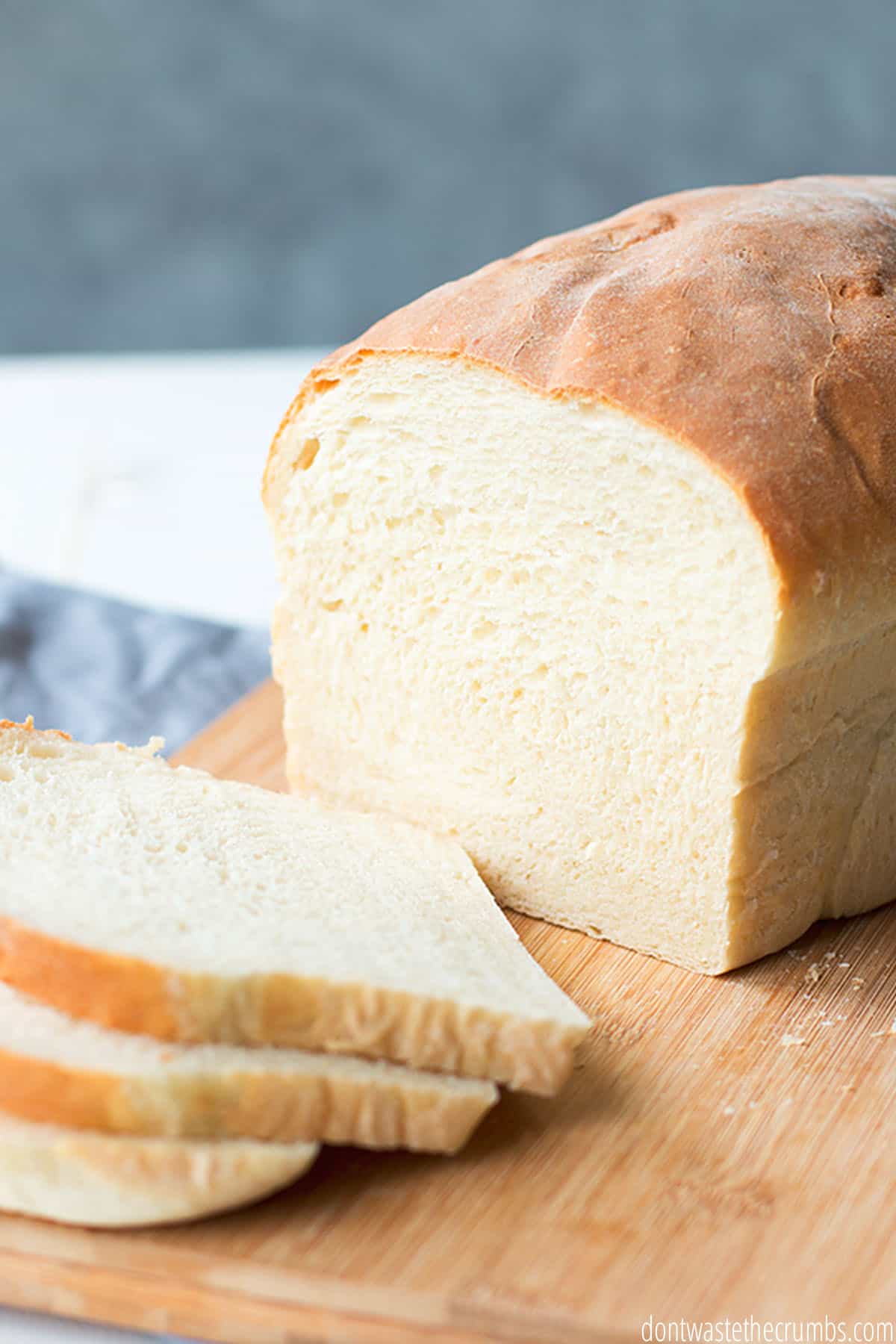
Q: Why is my bread dry and crumbly?
A: The two most likely culprits are either the dough was mixed for too long or was allowed to rise for too long.
Fix: Knead bread just until smooth and elastic, and let rise until just doubled in volume.
Q: Why is my bread dense and slightly undercooked?
A: Either the oven was too hot or the bread didn’t fully bake.
Fix: Use an oven thermometer to verify the temperature of the oven, and allow the bread to bake until an internal thermometer reaches 190F or sounds hollow when thumped.
Q: Why is my bread going stale so quickly?
A: Your recipe might be lacking a natural preservative: fat.
Fix: Add a small amount of fat to the recipe next time, 1 tsp should do the trick.
Q: Why is there a big hole in my bread when I slice it?
A: This could be from poor shaping or poor rise.
Fix: Be sure to shape your dough correctly, and slash the top using a sharp knife to help guide the direction of the dough in baking.
Q: One recipe makes too much bread for me, what should I do?
A: Try freezing baked dough instead of halving recipes.
Fix: The Ultimate Guide to Freezing Dough.
Conclusion About Baking Bread
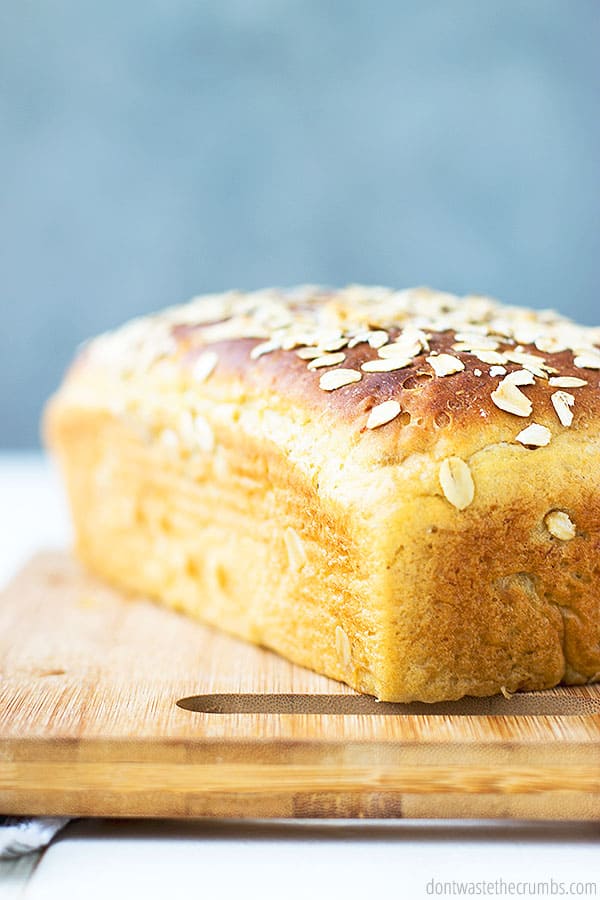
The best piece of advice any baker could give you in order to get the best bread possible is to practice! It takes a few rounds to know what “done” looks like, what a “hollow thump” sounds like, and what “smooth and elastic” feels like.
If your bread doesn’t turn out – for whatever reason – don’t give up! Try again and see if you can spot the error. Remember that the baking of bread is an art, not an exact science, and the more you practice your craft the better you’ll become!
More Easy Bread Recipes
- Spiced Carrot Bread
- Potato Buttermilk Bread
- How to Make Sourdough Starters
- Simple Sourdough Bread Recipe


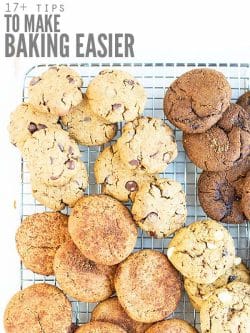
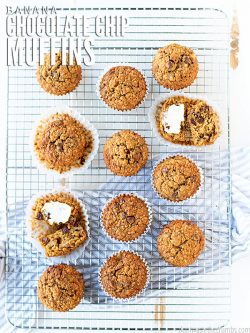
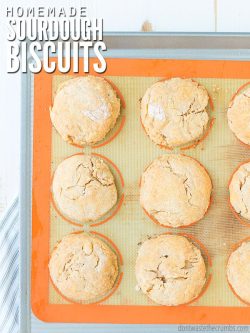
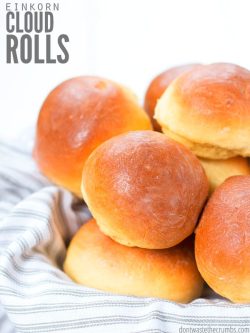

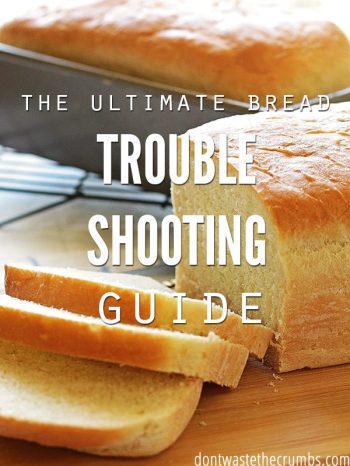
I have undercooked my sourdough bread I have sliced it already can I still put it back in the oven and bake it longer? Should I wrap it in foil when I put it in the oven and would 350 be the correct degrees. Thank you for the answer I made it for a church brunch and I hate to throw it out Ruby Lee
Hi Ruby,
Yes, you can put it back the oven if that ever happens again. Hope this helps!
I use Easy Bake yeast (fast yeast) and normally I use my bread machine. I’ve tried a couple of times to make bread without the machine and it rises on both provings, on the second proving I let get to the top of the tin (double the initial size) then bake the bread. It never gets above the top of the tin and is only about 4 inches tall. Tastes ok but I never get a good result like I do in my bread machine – any ideas please?
Gill,
Was your 2nd proving too long?
Hi Tiffany!
I came across this page in looking while looking for information for a project for my Masters Degree. Would I be able to use the link to this page as part of my project? We are looking at Constructivist Theory (learning by doing and accessing prior knowledge) and as a Foods Teacher, I am getting my classmates to make bread! But I’m looking for links to show some common bread making problems.
Please let me know if I can link to this post from our Google Sites page. It is only for a post-graduate class of 25 students!
Thanks!
Meg Irwin
Vernon, BC
Absolutely Meg!
Thank you for the great advice! Niw I knuw how to fix tge problem of a hole always appearing under the top crust. Now to find a really sharp knife.
Nit pick: Please fix the typos, you spelled hole as hold, and the english grammar is very awkward.
The typo is fixed, Nerka.
If Hodgson Mill is advertising their wheat flour as “non-GMO” they are playing a sleazy marketing trick. There has never been a single grain of GMO wheat on the market.
Kerry, Hodgson Mill works with the Non-GMO Project on a variety of their products. You can read more about their verification here: http://www.hodgsonmill.com/OurStandards/NonGMO.aspx
Lots of very good info here. Thanks.
Do you keep bread in the fridge? Mine molds super quick if I don’t. Do you think it’s too moist?
To stop the bread from molding add three tablespoons of apple cider vinegar per loaf. Of course, you will have to add more flour. I also add 3 tablespoons of oil, either Olive or avocado. This makes for a nice soft loaf.
Jerry
I have made my share of whole wheat bricks. The first thing that helped was wild captured yeast. I used the instructions that add pineapple juice to the flour the first couple of days, and it turned out fine. It doesn’t work exactly like sourdough. I use King Arthur bread flour when I put the starter out overnight. When I make bread, I use freshly ground whole wheat flour. I make a single loaf, since there are two of us. I also use this for my pizza dough, since I’ve been making pizza on Friday night. That also helps with my bread making on the weekend.
Some days I get a higher rise than others. I have to be careful not to let it rise too long. It’s never dense.
Hi Tiffany,
I found a great article online that I wanted to share with you and other readers, if I may. It’s a basic technique on how to shape a loaf of bread. Once I discovered this, my bread bakes more evenly and is much tastier. Hope it helps you too.
http://www.thekitchn.com/basic-techniques-how-to-shape-97063
Thanks Rachel!
Could we have a pin button, please?
Only have cell phone and can’t ‘hover’ on pictures. Some websites I can lightly tap photo and go straight to pinterest. Others, like yours, all I get is a picture by itself and/or a menu asking phone-type questions.
Thanks!
Thank you. Pinned.